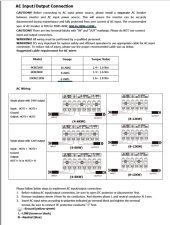BentleyJ
Solar Wizard
If the foregoing suggestions were confusing or misleading, apologies.I re-drew my plan.
What would be the purpose of the main panel besides providing the only earth ground? Could I purchase the same brand panel in 125A or 100A MAIN breaker style with more spaces and just rewire everything from the old panel to the new main breaker panel then the 80A breaker could fit into the new panel because it has more space. Would this alleviate the need to have the subpanel? I would just call this 100A panel in the first set of pictures a loss and fit a bigger Main breaker panel in the same space and just wire into that. I would probably go ahead and get a 125A panel if I can find it but with 20 spaces and just rewire that for a main panel. Buy the 80A double pole breaker and insert it and wire to the growatt 12kw.
Lets back up a bit. Discard the new drawing and refer back to the original. You only need one breaker panel with more spaces (or tandem breakers as Hedges mentioned) I believe a new, larger panel is a cleaner way to go and the price of new tandem breakers has to be compared to the new breaker panel price.
Main panel or subpanel doesn't matter what you call it or what is printed on the box, its a breaker panel or distribution panel. There are a couple of differences though.
1) A main panel typically has a main breaker and comes from the factory with a N-G bond. You don't need a "Main" type breaker per se, just a way to feed power in from the transfer switch. A 60A branch breaker would be just fine.
2) A subpanel typically does not have a main breaker (but may or may not have mechanical lugs on the end of the 2 Hot bus bars) and does not have a factory installed N-G bond.
In either case we can easily configure the panel for your particular use.
Not sure where the 80A number came from, doesn't matter? The 12K is only going to deliver 50A continuous (do you have any idea what your actual peak electrical use actually is? Doubtfull that the inverter would be operating at MAX all the time) there is no need for more than a 60A breaker. Nothing wrong with upgrading to the 4AWG wire if you prefer that and wish to keep voltage drop and heat losses down. Then just use the reducing pins.
If you add up all the items connected to the breaker panel and find that the normal load will be 6 to 8kW then for sure 6AWG wire is more than adequate. The deciding factor me would be that you already have the 6AWG and the distances are short, so use what you have.




